Teleradiology Software Market Size
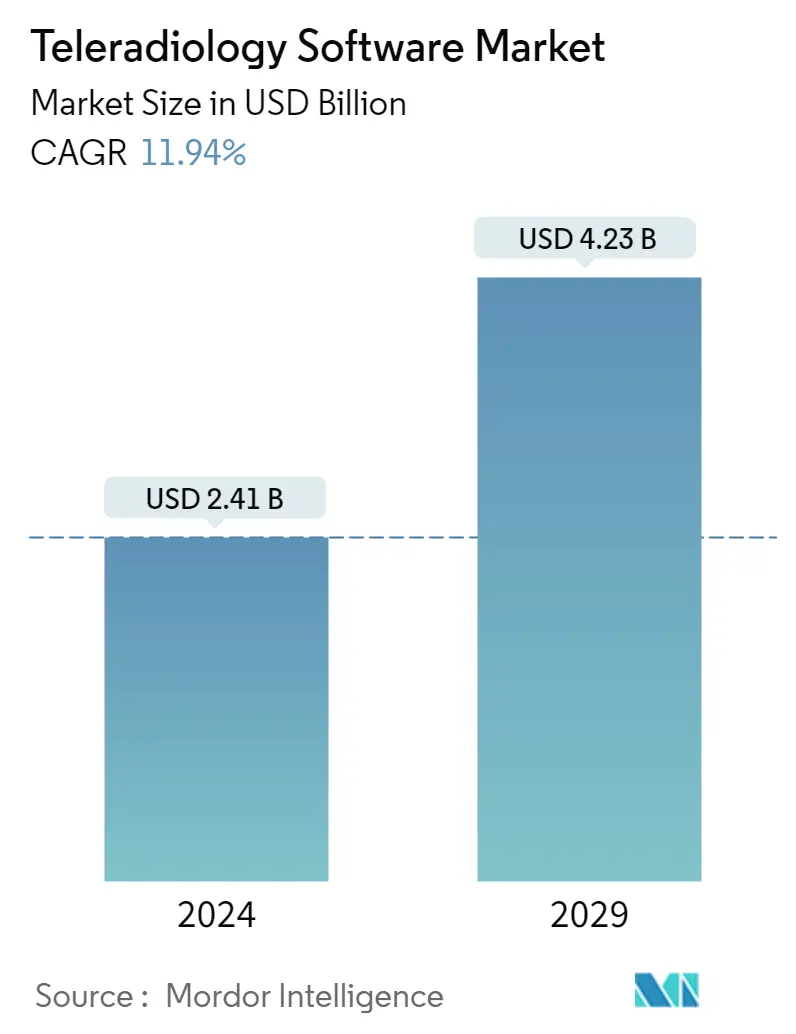
| Study Period | 2019 - 2029 |
| Market Size (2024) | USD 2.41 Billion |
| Market Size (2029) | USD 4.23 Billion |
| CAGR (2024 - 2029) | 11.94 % |
| Fastest Growing Market | Asia Pacific |
| Largest Market | North America |
| Market Concentration | Low |
Major Players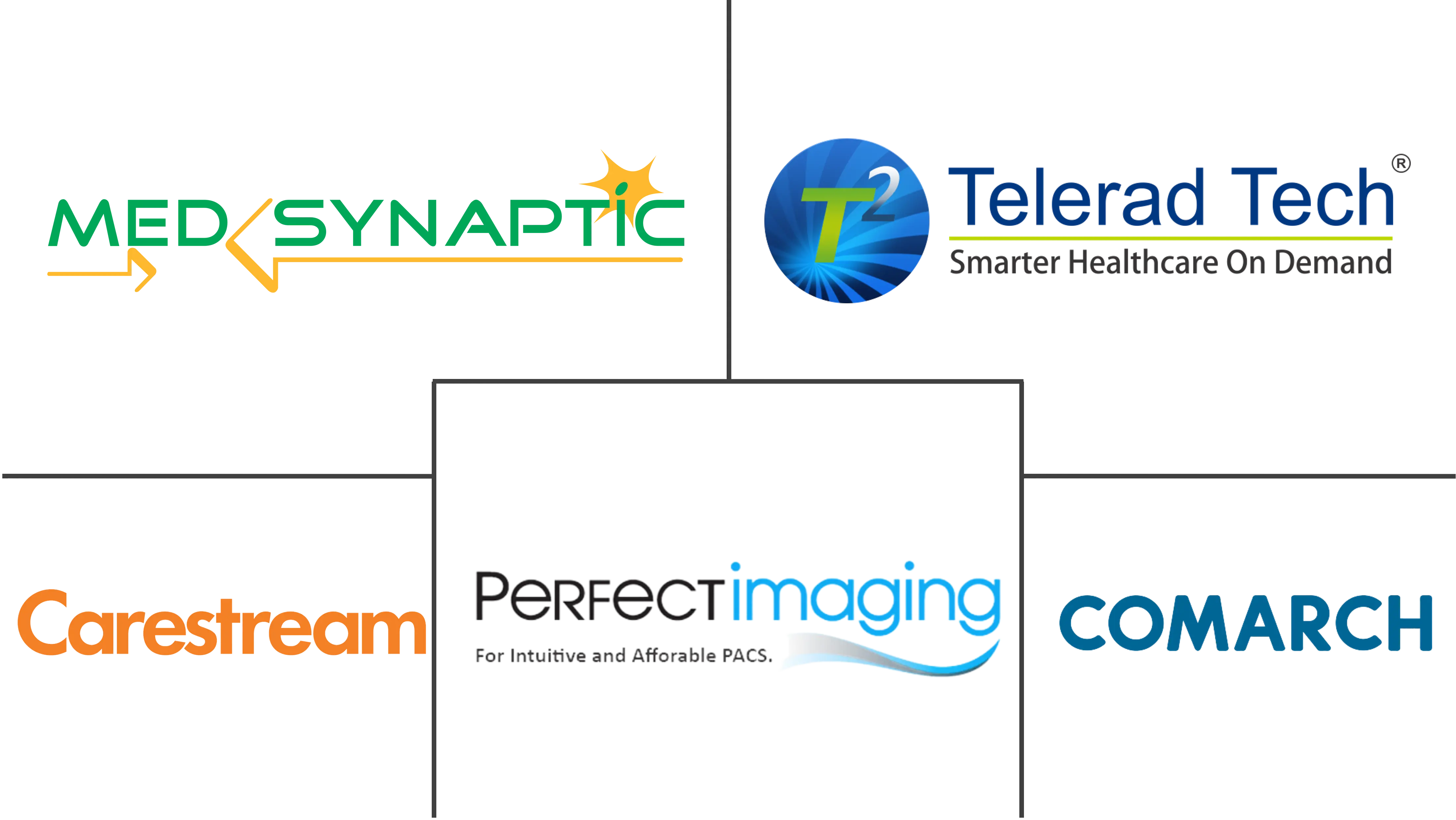
*Disclaimer: Major Players sorted in no particular order |
Teleradiology Software Market Analysis
The Teleradiology Software Market size is estimated at USD 2.41 billion in 2024, and is expected to reach USD 4.23 billion by 2029, growing at a CAGR of 11.94% during the forecast period (2024-2029).
- The teleradiology software market was significantly impacted by the COVID-19 pandemic, leading to increased adoption of teleradiology software. As per the article published in June 2022 in Oxford Academic, the Government of India implemented teleradiology during the pandemic and launched the CollabDDS Online Radiology Services (CORS) initiative. CORS is a web-based interface that provides an integrated online environment between remote health centers and expert radiologists and doctors in tertiary healthcare facilities to visualize and study radiological images in real time. The pandemic's impact on the teleradiology software market has, therefore, turned out to be positive.
- Currently, the growth of the teleradiology software market is expected to be even better due to the increasing availability of more affordable and faster wireless data transfer, mass storage options, and broadband cellular technology. The major factors driving market expansion include the increasing prevalence of chronic diseases such as cancer, heart disease, bone disorders, and other chronic diseases that require medical imaging and the rise in the adoption of teleradiology across hospitals and clinics.
- For instance, as per the data from the CARES Report 2021, 97.6% of adults and 2.4% of children were reported with out-of-hospital cardiac arrest (OHCA) in 2021 in the United States, and the median age of OHCA is considered to be 64 years. Early diagnosis of risk factors associated with cardiac arrest is being broadly carried out globally to cope with the rising prevalence of cardiac complications, fueling the market growth.
- Moreover, a rise in product launches, technological advancements, and implementation of digital health across hospitals are likely to drive market growth over the forecast period. For instance, in November 2022, Philips introduced new AI-enhanced informatics solutions to increase diagnostic confidence with intelligence at every step of the radiology workflow at RSNA. A new integrated diagnostic approach connects radiology, cardiology, pathology, and oncology to securely unite data and images across the enterprise, enabling earlier and more definitive diagnoses.
- Additionally, in April 2022, Teleradiology Solutions signed an agreement with Andhra Med Tech Zone (AMTZ) to develop a hub in the zone dedicated to offering remote radiology image reads by expert radiologists supported by breakthrough artificial intelligence (AI) solutions to the government and public sectors. This hub will be used to reach out to pan-India government hospitals, state-wide rural health centers (including those funded by the National Health Mission), and public-private partnerships with hospitals where TRS would provide remote radiology services. Thus, such product launches and government collaborations are likely to enhance the utilization of teleradiology software, leading to market growth over the forecast period.
- However, the shortage of skilled radiologists is likely to restrain market growth. Despite the positive impact of the COVID-19 pandemic on the teleradiology software market, this shortage of skilled radiologists may limit the market's growth potential.
Teleradiology Software Market Trends
Picture Archiving and Communication Systems (PACS) is Expected to Have a Significant Share in the Market Over the Forecast Period
- PACS, which stands for picture archiving and communication system, is a technology used in healthcare organizations to securely store and transmit electronic images and clinically-relevant reports. By providing timely and effective access to images, interpretations, and related data, PACS is able to overcome the physical and time barriers associated with traditional film-based image recovery, circulation, and display.
- The PACS segment is expected to see significant growth in the near future, driven by several factors. Firstly, the prevalence of chronic diseases that require imaging is increasing, creating a greater need for PACS technology. Secondly, the adoption of PACS in clinics and hospitals is on the rise as healthcare providers seek to improve patient outcomes and streamline diagnostic and treatment workflows. Finally, technological advancements in PACS are enabling more accurate and efficient diagnoses, further driving market growth.
- One notable application of PACS is in tumor diagnosis, where it offers high spatial and density resolution. A July 2022 article published in PubMed highlighted the importance of PACS in tumor diagnosis, underscoring its potential to contribute to improved patient outcomes.
- Breast cancer screening is another area where PACS technologies are widely utilized, and this is expected to drive market growth. In March 2022, for example, Philips PACS interoperability helped Scotland's National Health Service to deliver breast cancer screening more effectively. By allowing breast screening centers and mobile units to interoperate with the national PACS system, the technology increased access to breast screening for rural communities, enhanced patient choice, and streamlined workflows.
- In summary, the rise in chronic diseases requiring medical imaging, the increase in product launches, and technological advancements are all contributing to the growth of the PACS segment over the forecast period.
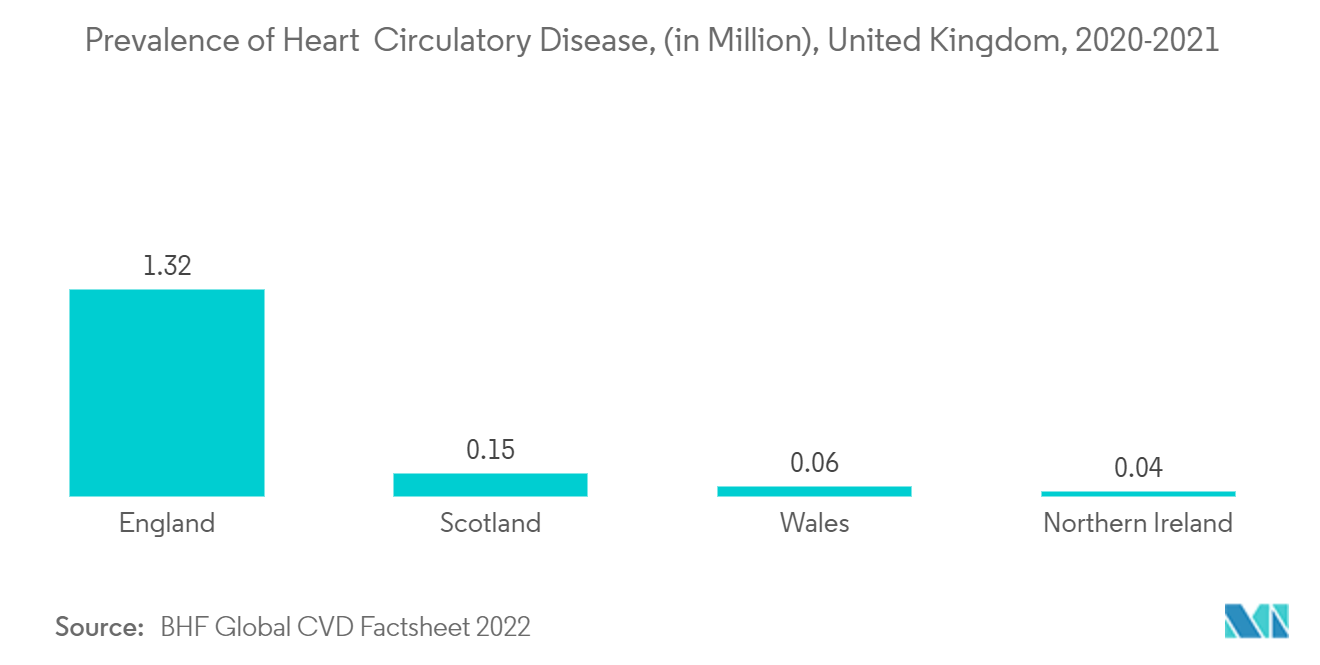
North America Anticipated to Hold a Significant Share in the Market Over the Forecast Period
- The teleradiology software market in North America is expected to experience substantial growth due to various factors, including a high prevalence of cancer and cardiovascular disease patients in the region, an increase in the adoption of teleradiology, and the presence of key players.
- According to the American Cancer Society 2023 Cancer Statistics, there is an estimated 1.9 million new cancer cases expected in the United States in 2023, with 1.01 million cases in males and 948 thousand cases in females. This high burden of cancer is driving the demand for medical imaging and teleradiology, which is expected to boost market growth over the forecast period.
- In March 2022, Royal Philips launched the Ultrasound Workspace at the American College of Cardiology's Annual Scientific Session & Expo (ACC 2022). This vendor-neutral echocardiography image analysis and reporting solution can be accessed remotely via a browser, enabling clinicians to utilize seamless diagnostic workflows from the ultrasound exam room to the reporting room and beyond, wherever echocardiography data needs to be reviewed and analyzed. Technological advancements like this by key players in the teleradiology software market are expected to drive market growth further.
- Additionally, strategic activities by major players in the region, such as Leveljump Healthcare Corp, a Canadian company specializing in B2B telehealth solutions, are expected to fuel growth. In November 2022, Leveljump Healthcare Corp's subsidiary, Canadian Teleradiology Services, signed definitive agreements to acquire four diagnostic imaging clinics, also known as independent healthcare facilities (IHFs), from private Alberta vendors. These IHFs offer medical imaging, including x-ray, ultrasound, fluoroscopy, and bone mineral density scans, and are all located in Calgary, Alberta, and surrounding areas.
- Thus, with the rise in chronic diseases that require medical imaging, the increase in product launches, and technological advancements, North America is likely to hold a significant market share in the teleradiology software market over the forecast period.
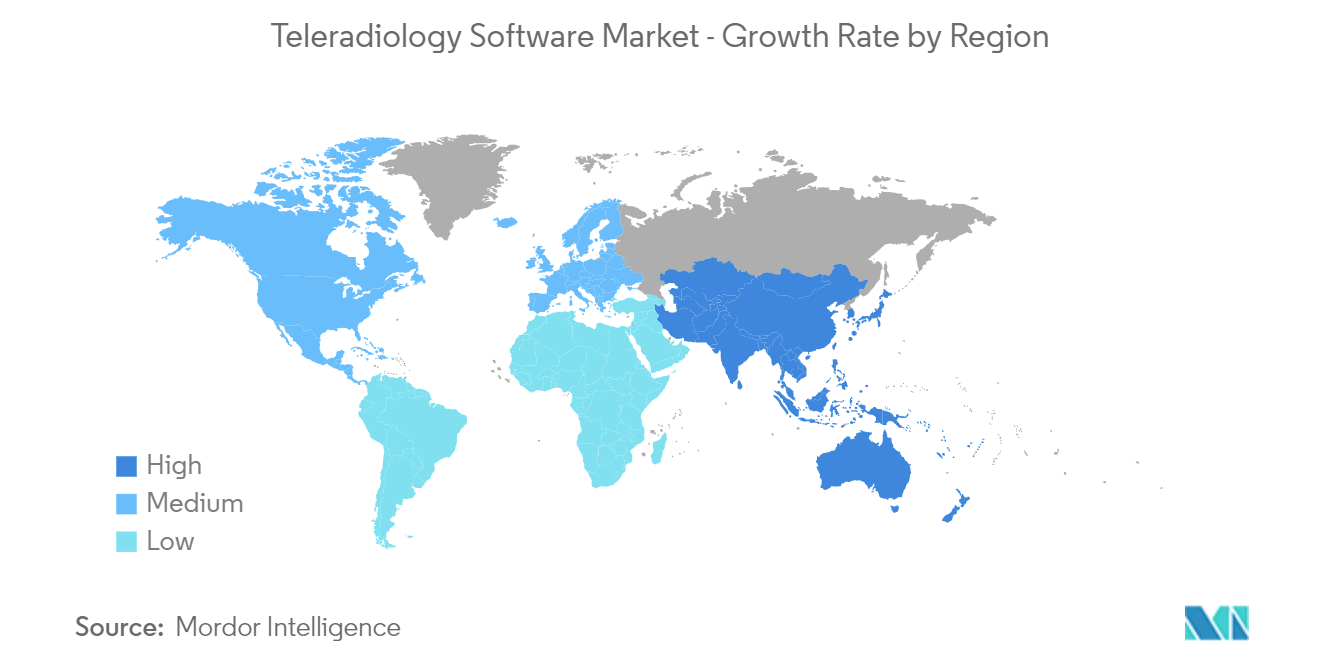
Teleradiology Software Industry Overview
The teleradiology software market is competitive and consists of several major players. Many market players adopted several strategic initiatives, such as mergers, acquisitions, and partnerships, to increase their presence and improve their market share. Some of the companies which are currently dominating the market are Carestream Health, Telerad Tech, Comarch SA, Medsynaptic Pvt Ltd, Perfect Imaging LLC, Impose Technologies Pvt Ltd., Morton & Partners Radiologists, and Radical Radiology.
Teleradiology Software Market Leaders
-
Carestream Health
-
Telerad Tech
-
Comarch SA
-
Medsynaptic Pvt Ltd
-
Perfect Imaging LLC
*Disclaimer: Major Players sorted in no particular order
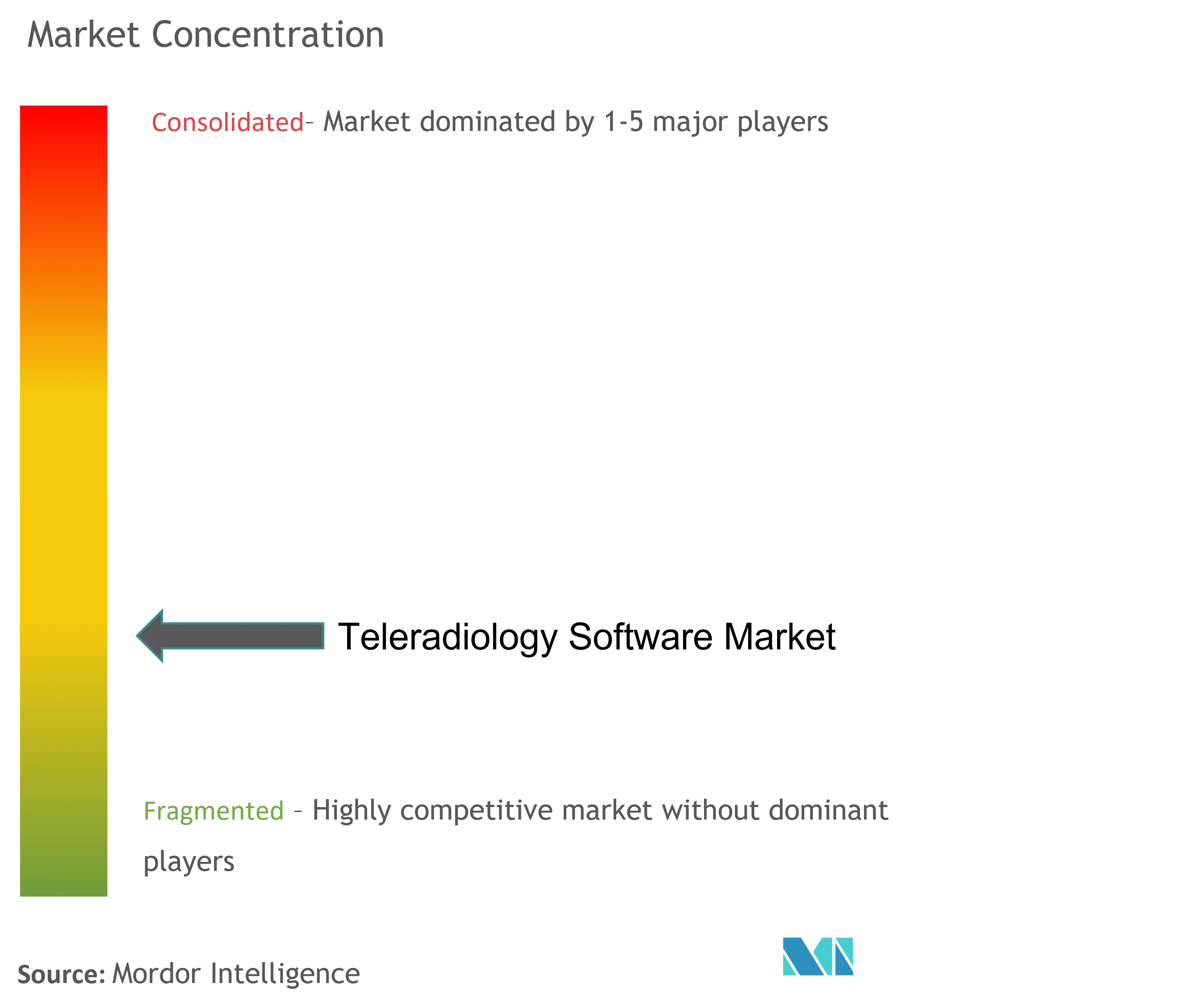
Teleradiology Software Market News
- November 2022: Radiology reporting specialist OpenRad launched its enterprise remote reporting platform, Enterprise Edition, which enables cloud-based reporting, collaborative workflows across companies, and advanced mobile fleet management in one offering. OpenRad Enterprise Edition allows imaging centers to fully leverage remote radiologists to speed up the diagnostic process, increase efficiency, improve patient experience, and reduce costs.
- May 2022: United Kingdom teleradiology services provider Hexarad launched OptiRad, a workflow management software application aimed at improving efficiency for radiology departments. OptiRad operates across several sites and assigns specialist reporting to the most appropriate radiologist to help improve radiology report turnaround time and diagnoses.
Teleradiology Software Market Report - Table of Contents
1. INTRODUCTION
1.1 Study Assumptions and Market Definition
1.2 Scope of the Study
2. RESEARCH METHODOLOGY
3. EXECUTIVE SUMMARY
4. MARKET DYNAMICS
4.1 Market Overview
4.2 Market Drivers
4.2.1 Increasing Incidence of Chronic Diseases
4.2.2 Rise in Adoption of the Teleradiology Software
4.3 Market Restraints
4.3.1 Shortage of Skilled Radiologists
4.4 Porter's Five Forces Analysis
4.4.1 Threat of New Entrants
4.4.2 Bargaining Power of Buyers/Consumers
4.4.3 Bargaining Power of Suppliers
4.4.4 Threat of Substitute Products
4.4.5 Intensity of Competitive Rivalry
5. MARKET SEGMENTATION (Market Size by Value - USD)
5.1 By Type
5.1.1 Radiology Information System
5.1.2 Picture Archive and Communication System
5.1.3 Vendor Neutral Archive
5.2 By Modality
5.2.1 Cloud-Based
5.2.2 On-Premise
5.3 Geography
5.3.1 North America
5.3.1.1 United States
5.3.1.2 Canada
5.3.1.3 Mexico
5.3.2 Europe
5.3.2.1 Germany
5.3.2.2 United Kingdom
5.3.2.3 France
5.3.2.4 Italy
5.3.2.5 Spain
5.3.2.6 Rest of Europe
5.3.3 Asia-Pacific
5.3.3.1 China
5.3.3.2 Japan
5.3.3.3 India
5.3.3.4 Australia
5.3.3.5 South Korea
5.3.3.6 Rest of Asia-Pacific
5.3.4 Middle East and Africa
5.3.4.1 GCC
5.3.4.2 South Africa
5.3.4.3 Rest of Middle East and Africa
5.3.5 South America
5.3.5.1 Brazil
5.3.5.2 Argentina
5.3.5.3 Rest of South America
6. COMPETITIVE LANDSCAPE
6.1 Company Profiles
6.1.1 Carestream Health
6.1.2 Telerad Tech
6.1.3 Comarch SA
6.1.4 Medsynaptic Pvt Ltd
6.1.5 Perfect Imaging LLC
6.1.6 Imagebytes Private Limited
6.1.7 Morton & Partners Radiologists
6.1.8 Radical Imaging LLC
6.1.9 eVisit
6.1.10 MILLENSYS
6.1.11 Everrtech
6.1.12 ONRAD, Inc.
- *List Not Exhaustive
7. MARKET OPPORTUNITIES AND FUTURE TRENDS
Teleradiology Software Industry Segmentation
As per the scope of the report, teleradiology is the transmission of radiological patient images, such as X-rays, CTs, and MRIs, from one site to another for the reason of sharing studies with other radiologists and physicians.
Teleradiology enhances patient care by allowing radiologists to provide services without having to be at the location of the patient. The teleradiology software market is segmented by type (radiology information system, picture archive, communication system, vendor-neutral archive), modality (cloud-based, on-premise), and geography North America, Europe, Asia-Pacific, Middle East and Africa, South America). The report also covers the estimated market sizes and trends for 17 countries across major regions globally.
The report offers the value (in USD) for the above segments.
| By Type | |
| Radiology Information System | |
| Picture Archive and Communication System | |
| Vendor Neutral Archive |
| By Modality | |
| Cloud-Based | |
| On-Premise |
| Geography | ||||||||
| ||||||||
| ||||||||
| ||||||||
| ||||||||
|
Teleradiology Software Market Research FAQs
How big is the Teleradiology Software Market?
The Teleradiology Software Market size is expected to reach USD 2.41 billion in 2024 and grow at a CAGR of 11.94% to reach USD 4.23 billion by 2029.
What is the current Teleradiology Software Market size?
In 2024, the Teleradiology Software Market size is expected to reach USD 2.41 billion.
Who are the key players in Teleradiology Software Market?
Carestream Health, Telerad Tech, Comarch SA, Medsynaptic Pvt Ltd and Perfect Imaging LLC are the major companies operating in the Teleradiology Software Market.
Which is the fastest growing region in Teleradiology Software Market?
Asia Pacific is estimated to grow at the highest CAGR over the forecast period (2024-2029).
Which region has the biggest share in Teleradiology Software Market?
In 2024, the North America accounts for the largest market share in Teleradiology Software Market.
What years does this Teleradiology Software Market cover, and what was the market size in 2023?
In 2023, the Teleradiology Software Market size was estimated at USD 2.15 billion. The report covers the Teleradiology Software Market historical market size for years: 2019, 2020, 2021, 2022 and 2023. The report also forecasts the Teleradiology Software Market size for years: 2024, 2025, 2026, 2027, 2028 and 2029.
Teleradiology Software Industry Report
Statistics for the 2024 Teleradiology Software market share, size and revenue growth rate, created by Mordor Intelligence™ Industry Reports. Teleradiology Software analysis includes a market forecast outlook to for 2024 to 2029 and historical overview. Get a sample of this industry analysis as a free report PDF download.



